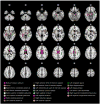Abnormal white matter integrity in antipsychotic-naïve first-episode psychosis patients assessed by a DTI principal component analysis
- PMID: 25620120
- PMCID: PMC4339463
- DOI: 10.1016/j.schres.2015.01.019
Abnormal white matter integrity in antipsychotic-naïve first-episode psychosis patients assessed by a DTI principal component analysis
Erratum in
-
Corrigendum to "abnormal white matter integrity in antipsychotic-naïve first-episode psychosis patients assessed by a DTI principal component analysis" [Schizophr. Res. 162 (1-3) (march 2015) 14-21].Schizophr Res. 2016 Oct;176(2-3):582. doi: 10.1016/j.schres.2016.05.025. Epub 2016 Jun 2. Schizophr Res. 2016. PMID: 27264503 No abstract available.
Abstract
Introduction: Diffusion tensor imaging (DTI) studies in patients with schizophrenia have shown abnormalities in the microstructure of white matter tracts. Specifically, reduced fractional anisotropy (FA) has been described across multiple white matter tracts, in studies that have mainly included patients treated with antipsychotic medications.
Objective: To compare FA in antipsychotic-naïve patients experiencing a first episode of psychosis (FEP) to FA in healthy controls to demonstrate that the variance of FA can be grouped, in a coincidental manner, in four predetermined factors in accordance with a theoretical partition of the white matter tracts, using a principal components analysis (PCA).
Methods: Thirty-five antipsychotic-naïve FEP patients and 35 age- and gender-matched healthy controls underwent DTI at 3T. Analysis was performed using a tract-based spatial statistics (TBSS) method and exploratory PCA.
Results: DTI analysis showed extensive FA reduction in white matter tracts in FEP patients compared with the control group. The PCA grouped the white matter tracts into four factors explaining 66% of the total variance. Comparison of the FA values within each factor highlighted the differences between FEP patients and controls.
Discussion: Our study confirms extensive white matter tracts anomalies in patients with schizophrenia, more specifically, in drug-naïve FEP patients. The results also indicate that a small number of white matter tracts share common FA anomalies that relate to deficit symptoms in FEP patients. Our study adds to a growing body of literature emphasizing the need for treatments targeting white matter function and structure in FEP patients.
Keywords: Diffusion tensor imaging; First-episode psychosis; Fractional anisotropy; Principal component analysis; Schizophrenia; TBSS.
Copyright © 2015 Elsevier B.V. All rights reserved.
Conflict of interest statement
Figures


Similar articles
-
Abnormal white matter microstructure in drug-naive first episode schizophrenia patients before and after eight weeks of antipsychotic treatment.Schizophr Res. 2016 Apr;172(1-3):1-8. doi: 10.1016/j.schres.2016.01.051. Epub 2016 Feb 3. Schizophr Res. 2016. PMID: 26852402
-
Extensive white matter abnormalities and clinical symptoms in drug-naive patients with first-episode schizophrenia: a voxel-based diffusion tensor imaging study.J Clin Psychiatry. 2016 Feb;77(2):205-11. doi: 10.4088/JCP.14m09374. J Clin Psychiatry. 2016. PMID: 26761708
-
State-dependent microstructural white matter changes in drug-naïve patients with first-episode psychosis.Psychol Med. 2017 Nov;47(15):2613-2627. doi: 10.1017/S0033291717001015. Epub 2017 Aug 22. Psychol Med. 2017. PMID: 28826419
-
The role of diffusion tensor imaging and fractional anisotropy in the evaluation of patients with idiopathic normal pressure hydrocephalus: a literature review.Neurosurg Focus. 2016 Sep;41(3):E12. doi: 10.3171/2016.6.FOCUS16192. Neurosurg Focus. 2016. PMID: 27581308 Review.
-
The effect of antipsychotic medications on white matter integrity in first-episode drug-naïve patients with psychosis: A review of DTI studies.Asian J Psychiatr. 2021 Jul;61:102688. doi: 10.1016/j.ajp.2021.102688. Epub 2021 May 11. Asian J Psychiatr. 2021. PMID: 34000500 Review.
Cited by
-
The integrity of the corticospinal tract and corpus callosum, and the risk of ALS: univariable and multivariable Mendelian randomization.Sci Rep. 2024 Jul 26;14(1):17216. doi: 10.1038/s41598-024-68374-y. Sci Rep. 2024. PMID: 39060317 Free PMC article.
-
Effect of DAOA genetic variation on white matter alteration in corpus callosum in patients with first-episode schizophrenia.Brain Imaging Behav. 2021 Aug;15(4):1748-1759. doi: 10.1007/s11682-020-00368-6. Brain Imaging Behav. 2021. PMID: 32748316
-
White matter alterations and the conversion to psychosis: A combined diffusion tensor imaging and glutamate 1H MRS study.Schizophr Res. 2022 Nov;249:85-92. doi: 10.1016/j.schres.2020.06.006. Epub 2020 Jun 25. Schizophr Res. 2022. PMID: 32595100 Free PMC article.
-
Multimodal assessment of white matter microstructure in antipsychotic-naïve schizophrenia patients and confounding effects of recreational drug use.Brain Imaging Behav. 2021 Feb;15(1):36-48. doi: 10.1007/s11682-019-00230-4. Brain Imaging Behav. 2021. PMID: 31909444
-
Machine learning classification of first-episode schizophrenia spectrum disorders and controls using whole brain white matter fractional anisotropy.BMC Psychiatry. 2018 Apr 10;18(1):97. doi: 10.1186/s12888-018-1678-y. BMC Psychiatry. 2018. PMID: 29636016 Free PMC article.
References
-
- Astrakas LG, Argyropoulou MI. Shifting from region of interest (ROI) to voxel-based analysis in human brain mapping. Pediatr Radiol. 2010;40(12):1857–1867. - PubMed
-
- Basser PJ, Pierpaoli C. Microstructural and physiological features of tissues elucidated by quantitative-diffusion-tensor MRI. J Magn Reson B. 1996;111(3):209–219. - PubMed
-
- Beaulieu C. The basis of anisotropic water diffusion in the nervous system - a technical review. NMR Biomed. 2002;15(7-8):435–455. - PubMed
-
- Bryant FB, Yarnold PR. Principal-components analysis and confirmatory factor analysis. In: Grimm LG, Yarnold PR, editors. Reading and understanding multivariate statistics. American Psychological Association; Washington, DC: 1995. pp. 99–136.
-
- Caligiuri MP, Lohr JB. A disturbance in the control of muscle force in neuroleptic-naive schizophrenic patients. Biol Psychiatry. 1994;35(2):104–111. - PubMed
Publication types
MeSH terms
Grants and funding
LinkOut - more resources
Full Text Sources
Other Literature Sources
Medical

